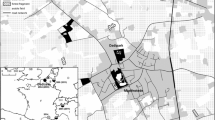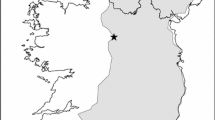Abstract
Arboreal squirrels of the Asiatic genus Callosciurus have shown high likelihood of establishment from few released animals, in particular, C. erythraeus has established wild populations in Argentina, Belgium, France, Hong Kong, Japan, and The Netherlands. We report the invasion process of C. erythraeus in Argentina in the last four decades and suggest management actions for each foci. Between February 2011 and November 2014 we conducted field surveys and interviews in nine sites in central Argentina to confirm the presence of C. erythraeus, describe their history of introduction, and estimate range expansion and squirrel relative abundance. We report a two decades lag-phase until the onset of translocations of C. erythraeus within national boundaries that resulted in a constant increase of the cumulative number of releases. We confirm nine new release events between 1995 and 2012 and six new invasion foci that yields a total of 13 deliberate releases and 10 invasion foci established in rural and urban areas of Argentina. Spread rate ranged from 0.12 to 0.66 km/year. An intermediate relative density of squirrels (2–7 ind/ha) was found close to release sites except in one case. All introduction events involved squirrels translocated from the first, 40 years old invasion focus, occasionally involving illegal trade. The rate of introduction events in the last decades and the translocation-lag phase described in this study should call the attention in all countries dealing with charismatic, introduced species. Translocation disruption requires urgent attention to slow down the invasion of this and other species.



Similar content being viewed by others
References
Andow DA, Kareiva PM, Levin SA, Okubo A (1993) Spread of invading organisms: patterns of dispersal. In: Kim KC, McPheron BA (eds) Evolution of insect pests. John Wiley, New York, pp 219–242
Aprile G, Chicco D (1999) Nueva especie exótica de mamífero en la Argentina: la ardilla de vientre rojo Callosciurus erythraeus. Mastozoología Neotropical 6:7–14
Bayne E, Hobson K (2000) Relative use of contiguous and fragmented boreal forest by red squirrels (Tamiasciurus hudsonicus). Can J Zool 78:359–365
Benitez VV, Almada Chavez S, Gozzi AC, Messetta ML, Guichón ML (2013) Invasion status of Asiatic red-bellied squirrels in Argentina. Mamm Biol 78:164–170
Bertolino S (2009) Animal trade and non-indigenous species introduction: the world-wide spread of squirrels. Divers Distrib 15:701–708
Bertolino S, Genovesi P (2003) Spread and attempted eradication of the grey squirrel (Sciurus carolinensis) in Italy, and consequences for the red squirrel (Sciurus vulgaris) in Eurasia. Biol Conserv 109:351–358
Bertolino S, Lurz PWW (2013) Callosciurus squirrels: worldwide introductions, ecological impacts and recommendations to prevent the establishment of new invasive populations. Mammal Rev 43:22–33
Bertolino S, Cordero di Montezemolo N, Preatoni DG, Wauters LA, Martinoli A (2014) A grey future for Europe: Sciurus carolinensis is replacing native red squirrels in Italy. Biol Invasions 16:53–62
Blackburn TM, Pysek P, Bacher S, Carlton JT, Duncan RP, Jarosik V, Wilson JRU, Richardson DM (2011) A proposed unified framework for biological invasions. Trends Ecol Evol 26:333–339
Borgnia M, Benitez V, Gozzi C, Guichón ML (2013) La ardilla de vientre rojo en Argentina y el manejo de especies introducidas como un problema biológico y social. Ecología Austral 23:147–155
Bridgman LJ, Benitez VV, Graña Grilli M, Mufato N, Acosta D, Guichón ML (2012) Short perceptual range and yet successful invasion of a fragmented landscape: the case of the red-bellied tree squirrel (Callosciurus erythraeus) in Argentina. Landsc Ecol 27:633–640
Cassini G, Guichón ML (2009) Variaciones morfológicas y diagnosis de la ardilla de vientre rojo, Callosciurus erythraeus (Pallas, 1779), en Argentina. Mastozoología Neotropical 16:39–47
Clark B (2014) Earth Point, tools for Google Earth. http://www.earthpoint.us/. Accessed 25 Sep 2014
Crooks JA (2005) Lag times and exotic species: the ecology and management of biological invasions in slow-motion. Ecoscience 12:316–329
Estévez RA, Anderson CB, Pizarro JC, Burgman MA (2014) Clarifying values, risk perceptions, and attitudes to resolve or avoid social conflicts in invasive species management. Conserv Biol. doi:10.1111/cobi.12359
Gabrielli M, Cardoso Y, Benitez V, Gozzi AC, Guichón ML, Lizarralde M (2014) Genetic characterization of Callosciurus Asiatic squirrels introduced in Argentina. Ital J Zool 81:328–343
Gozzi AC, Guichón ML, Benitez VV, Lareschi M (2013) Arthropod parasites of the red-bellied squirrel Callosciurus erythraeus (Rodentia: Sciuridae) introduced into Argentina. Med Vet Entomol 27:203–208
Gozzi AC, Guichón ML, Benitez VV, Troyelli A, Navone GT (2014) Gastro-intestinal helminths in the red-bellied squirrel introduced into Argentina: accidental acquisitions and lack of specific parasites. Hystrix 25:97–102
Guichón ML, Doncaster CP (2008) Invasion dynamics of an introduced squirrel in Argentina. Ecography 31:211–220
Guichón ML, Bello M, Fasola ML (2005) Expansión poblacional de una especie introducida en la Argentina: la ardilla de vientre rojo Callosciurus erythraeus. Mastozoología Neotropical 12:189–197
Gurnell J, Wauters LA, Lurz PWW, Tosi G (2004) Alien species and interspecific competition: effects of introduced eastern grey squirrels on red squirrel population dynamics. J Anim Ecol 73:26–35
Heger T, Jeschke JM (2014) The enemy release hypothesis as a hierarchy of hypotheses. Oikos 123:741–750
Jacobs MH, Vaske JJ, Dubois S, Fehres P (2014) More than fear: role of emotions in acceptability of lethal control of wolves. Eur J Wildl Res. doi:10.1007/s10344-014-0823-2
Jeschke JM (2014) General hypothesis in invasion ecology. Divers Distrib 20:1229–1234
Jessen RR, Merrick MJ, Koprowski JL, Ramirez O (2010) Presence of Guayaquil squirrels on the central coast of Peru: an apparent introduction. Mammalia 74:443–444
Koprowski JL (2005) The response of tree squirrels to fragmentation: a review and synthesis. Anim Conserv 8:369–376
Lockwood JL, Cassey P, Blackburn T (2005) The role of propagule pressure in explaining species invasions. Trends Ecol Evol 20:223–228
Lurz PWW, Hayssen V, Geissler K, Bertolino S (2013) Callosciurus erythraeus (Rodentia: Sciuridae). Mamm Species 45:60–74
McNeely JA (2001) An introduction to human dimensions of invasive species. In: McNeely JA (ed) The great reshuffling: human dimensions of invasive alien species. IUCN, Gland, pp 5–20
Palmer GH, Koprowski J, Pernas T (2007) Tree squirrels as invasive species: conservation and management implications. In: Witmer GW, Pitt WC, Fagerstone KA (eds) Managing vertebrate invasive species. USDA National Wildlife Research Center Symposia, University of Nebraska, Lincoln, p 273–282
Parker T, Nilon C (2008) Gray squirrel density, habitat suitability, and behavior in urban parks. Urban Ecosyst 11:243–255
Ruiz GM, Carlton JT (2003) Invasion vectors: a conceptual vector for management. In: Ruiz GM, Carlton JT (eds) Invasive species: vectors and management strategies. Island Press, Washington DC, pp 459–504
SIGA (2014) Sistema de información y gestión agrometeorológico. Instituto Nacional de Tecnología Agropecuaria, Argentina. http://siga2.inta.gov.ar/en/datoshistoricos. Accessed 25 Aug 2014
Simberloff D (2014) Biologial invasions: what’s worth fighting and what can be won? Ecol Eng 64:112–121
With KA (2002) The landscape ecology of invasive spread. Conserv Biol 16:1192–1203
Wittenberg R, Cock MJW (eds) (2001) Invasive alien species: a toolkit of best prevention and management practices. CAB International, Wallingford
Wood DJA, Koprowski JL, Lurz PWW (2007) Tree squirrel introduction: a theoretical approach with population viability analysis. J Mammal 88:1271–1279
Zar JH (1996) Biostatistical analysis, 3rd edn. Prentice Hall, Englewood Cliffs
Acknowledgments
We thank A. Troyelli, B. Baguette Pereiro and C. Lallana Ovejero for fieldwork assistance. Local support in each site: V. Dell Arciprete and H. Feigrós in 25 de Mayo; R. Gallardo, T. Cristie and J. Gachet in San Miguel; G. Consoli, G. Facello and P. Heredia in Capitán Sarmiento; S. Ballina, P. Siroski and E. Mosso in Rafaela. Hundreds of residents and personnel of ranches and rural institutes collaborated with our interviews and in some cases also allowed us to survey within their properties. F. Milesi provided several constructive suggestions. This study was supported by the Universidad Nacional de Luján.
Author information
Authors and Affiliations
Corresponding author
Rights and permissions
About this article
Cite this article
Guichón, M.L., Benitez, V.V., Gozzi, A.C. et al. From a lag in vector activity to a constant increase of translocations: invasion of Callosciurus squirrels in Argentina. Biol Invasions 17, 2597–2604 (2015). https://doi.org/10.1007/s10530-015-0897-0
Received:
Accepted:
Published:
Issue Date:
DOI: https://doi.org/10.1007/s10530-015-0897-0




